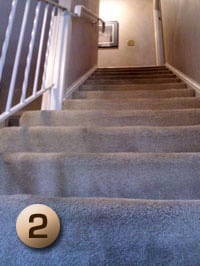NuStair: Stair Tread
With the NuStair stair system, you eliminate a lengthy, messy three-step process involved in stair remodeling. This gives you a 3-hour head start when using NuStair!
Stair Remodeling the Old Way
In a typical 13-rise staircase, you would have to:
 |  |  |
| Cut all the substrate or framing noses off. | Cut, clean, and refill all the mortise holes. | Then you’re left with all the sawdust to clean up! |
Prior to NuStair, stair treads were typically 1” thick x 11.5” deep x 36-72” long. They usually were made of red oak with a bull nose.
The installation of these older stair treads requires a tremendous amount of work preparing the original substrate framing. Depending on the situation, the existing stair treads may have to come out completely, or the substrate nose on the framing needs to be removed.
The latter is most common and requires a plunge cut with a circular saw in the middle of the stair tread. This can result in a kickback, cutting into existing fasteners, cutting into the existing substrate riser, and creating sawdust in the house. The blade frame also inhibits the saw from making the cut all the way to the stringer.
A fan blade or hand saw must then be used to complete the cut. Once the cut is complete, the mortise joint must be cleaned out and filled in with a wood compound.
On a typical 13-rise staircase this process takes about 3 hours, not counting the time to prepare the equipment!
Additionally, Boca code states that the rise of a staircase cannot vary by more than ⅛”. Adding a 1” tread above the floor and below the landing does not meet this criterion. Because of this, virtually every stair remodel job that has been done prior to NuStair Stair Fitter does not meet code!
Stair Remodeling the NuStair Way
NuStair is a simple and subtle solution to the retread process.
The NuStair treads come in two widths – ⅜” and ⅝”. The leading edge has a 1 ½” nosing and scotia molding that is permanently bonded to the body of the tread. The NuStair riser is ¾” thick and comes with 3” x 36” poplar shims.
The NuStair process eliminates all the requirements described in the Old Way above.
With this new process, your project is now 3 to 4 hours ahead of the old system with no sawdust in the house or expense of wood fillers or saw blades (or medical bills).
With NuStair, you simply place the ¾” riser over the substrate riser to achieve a flush fit with the framing lip which extends out typically ¾”. In some cases, the framing lip extends out farther, in which case you just install the right depth of shims to keep the riser flush.
The NuStair retread with the perpendicular 1 ½” nosing and scotia covers the framing lip and the top of the riser cut.
Order your NuStair Stair Treads today and save another day!
Our Stair Tread Blog Posts:
- 4 Design Ideas to Make Your Stairs Stand Out
- 5 Things That Make Your Staircase Unsafe
- 4 Ways to Make Staircases More Accessible for the Elderly
- Re-Carpet, Rebuild, or NuStair? What You Need to Know When Choosing
- Our 7 Favorite Creative Stair Risers
- Paint & Stain Combinations for Your Staircase
- 3 Ways a Refreshed Staircase Can Impact the Value of Your Home
- Guide to Staircase Handrails
- How to Properly Care for Your Wood Floors (& Stairs!)
- 4 Health Benefits of Wooden Staircases & Flooring
- Installing an Open-Sided Staircase With Adjustable Wood Balusters
- Installing NuStair on an Open-Sided Staircase With Adjustable Iron Balusters
- 3 Signs It’s Time to Renovate Your Stairs







